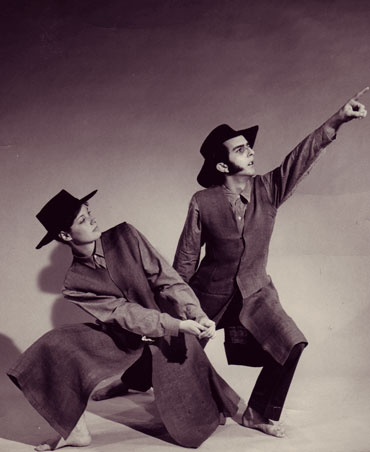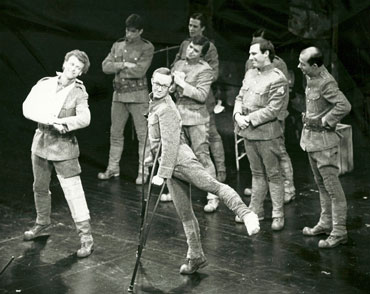Dancers Over 40 ARTS Legacy

DAVID JAMES
DO40 continues its ARTSLegacy series honoring all of our members. These written transcripts will also be donated to the Jerome Robbins Dance Collection at the New York Public Library for the Performing Arts at Lincoln Center, and eventually into a compilation suitable for publishing. In this issue we present DO40 member Kevin Winkler (and author of BIG DEAL: Bob Fosse and Dance in the American Musical) and our first-ever overseas member, David James! (We are getting around!) ARTSLegacy is an added benefit for people who do not live in the tri-state area, or who are in NYC and might not be able to participate in our panels. The questions can be answered by phone or by computer, so no need to travel or to dress up for the interview! Call the DO40 hotline at 212-330-7016 or email us at dancersover40@aol.com if you are interested! What inspired you to want to become a dancer? I’m a pretty mediocre dancer – I’m totally left-sided and can’t remember combinations (my career has been as a costume designer and a writer), but I’ve always gone to class. But for the last two years, I’ve been touring with disabled performer Liz Carr in her show Assisted Suicide- the Musical and doing new burlesque, so hey, at 72, I’m finally a pro. Growing up in the Ohio countryside, there was no culture, so it was entirely Ed Sullivan. I remember Gwen Verdon doing “A Little Brains, a Little Talent” and Elizabeth Seal exploding across the stage as Irma la Douce like it was yesterday. And, of course, Eddie Villella and Nureyev. I didn’t take a class until I got to college, and even then, it was pretty much folk dancing. Then, when I was a junior, Lavina Nielson joined the faculty. Vinnie had been a soloist with Limon and was in the original production of On the Town. She was a huge personality, and led us all through Graham, Humphrey-Weidman (we danced ‘The Shakers’), Mary Wigman and Kurt Jooss (she’d danced with Harold Kreutzberg). During my last two summers in Ohio they were setting what became the Ohio Ballet in Akron, and I got to study with Heinz Poll, Catherine Firestone, the beautiful Sarah Stackhouse and Jose Limon. Who was the most influential in your career? A few months after I got to New York, when I was working at Brooks Van Horn, Connie Wexler, the assistant costume designer on Promises Promises, hired me to do a costume bible for the show, notating everything, I got to spend three weeks backstage at the Shubert, where I got to see BROADWAY at its very finest and most glorious from the inside. The rigor and creativity and energy and professionalism - it was like a punch in the gut – you’ve got to be THIS good. I spent a lot of time hanging out in the chorus dressing rooms with that superb assemblage of dancers. It’s where I first met Baayork Lee, who’s still such a good friend. Subsequently, I worked on shows with Michael Bennett, Bob Fosse, Michael Kidd, Onna White, Patricia Birch and Larry Fuller. And I designed for Alvin Ailey, Gerald Arpino, Vicente Nebrada, Michael Uthoff and Norman Walker. What teacher had the most influence on your career? I’ve learned so much from so many. I’d say Bob Joffrey (for his quiet authority, graciousness and attention to detail), Michael Bennett (the best story-teller) and Margo Sappington, watching her create ‘Rodin’ for the Harkness, where she got her dancers to give every ounce with sheer positive encouragement, vs. intimidation and fear. 
What was the most memorable experience you can remember? I loved Paul Taylor’s work, but all they offered at his school was advanced repertoire & technique, for which I was totally unqualified (and I was 41). But I wanted to know what he was thinking and what it felt like. Cynthia O’Neal, who was on his board, and Jimmy Karr, who was one of his soloists, both told me I should do it anyway. I went in the first morning, sweating bullets, and explained that at least I knew I didn’t know what I was doing. It remains a high point in my life. A week each in the studio with Susan McGuire, Kate Johnson and Cathy McCann, each so different, yet so extraordinary. Cathy taught me about absolutely dancing through your back. And I only ran into one person in the whole three weeks! I went back for two more years of summer sessions. To this day, when I watch Paul’s work, I can feel it in my body, and that’s a gift to my life. It also started one week after my best friend had died. Believe me, there’s nothing like being in the middle of 30 ace dancers moving very fast to really concentrate the mind away from grief. Do You Have A Most Frightening Or Funny Dance Experience? Doing the gay pride march with the “Dream Team” (Dancers Responding to AIDS), which Hernando Cortez of the Taylor Company set up). Bill T. Jones and I were hanging in the back, saying “Aw, we’re too old for this,” but by the time we got to 52nd Street, Bill couldn’t stand it and was leaping about. And by the time we got to 45th Street, I was up there, too. There was a picture of us all on the front page of the Times, bell-kicking in front of the public library. Then, when we were making the last turn, from Christopher Street onto Hudson, I jeted into a pothole and went down like a stone. Blood everywhere! What Experience Or Legacy Would You Like To Pass On To The Next Generation? Feel and savour the flavour of what you’re dancing in your body. Juan Carlos Copes, from Tango Argentino once said in class, “You must dance like you have a knife in your pocket.” And always remember you’re telling a story!
|
KEVIN WINKLER
What inspired you to become a dancer? I grew up in a small rural area of northeastern Oklahoma, and there was no theater or dance. But we had movies. My earliest memories of wanting to perform were from seeing dancers on screen. I loved movie musicals, especially those with lots of dancing. My favorites were the usual suspects: Fred Astaire and Ginger Rogers, Gene Kelly, Vera-Ellen, Ann Miller, and a phenomenal dancer whom I later learned was Tommy Rall. Television variety shows like those of Ed Sullivan and Carol Burnett always had lots of dancing, and I was in love with the 1960s jazz dance choreography that so many of them featured. I only later learned that the style was derived from the work of Jack Cole. 
Who was the most influential in your career? I can’t think of any one person who was most influential in my career. Everyone I worked with as a dancer gave me something unique—a different perspective on the work, a sense of discipline, a new or different way of being an artist. What teacher had the most influence on your career? I didn’t start serious dance training until my family moved to San Diego when I was in high school. I began taking classes at San Diego Ballet, and then I was a theater major and dance minor at San Diego State University. The dance program at that time was focused on modern dance, but I had a jazz teacher named Day Power (yes, that was his name) who really pushed me to dance fearlessly. I was a good jazz dancer, and he later encouraged me to teach, which I did for a time. Later, when I moved to New York City, I studied for a number of years with Larry Stevens, who was rather eccentric, but an excellent teacher, and one who taught me a lot in a short period of time. I haven’t seen him in years and I’m not sure whatever happened to him, but he was marvelous. I owe him a lot. What was the most memorable dance experience you can remember? In 1982 I was a young dancer cast in the revival of Little Me, a show Fosse had choreographed and co-directed twenty years earlier. He wasn’t involved in the revival but did come in during previews to stage one of the numbers with his original choreography. Fosse was like God to the dancers and we worked like demons to give him the performances he demanded. It was this personal experience that I used to open my book. I vividly remember arriving for the first day of rehearsals with Fosse, and all of us were keyed up, ready to really dance. But he didn’t start with the dance. Rather, he began with the actors and the scene leading into the song and dance, setting the tone for what would come next. He worked with the musical director to bring music in quietly under the dialogue. When song and dance were finally introduced, it all felt organic, as if one flowed from the other naturally. It was a lesson in musical staging I still remember, and one of the reasons he was so revered. Do you have a most frightening or funny dance experience you can remember? At one point during the number we were working on with Fosse, I was required to pick up the girl next to me and sit her on my shoulder. At that time, I was very bad at performing lifts—I was skinny and had no upper body strength. The original 98-pound weakling! (I won’t tell you how many girls I dropped during my career. . . .) Well, I was panicked, convinced I couldn’t do it. But before I knew it, Fosse was standing in front of me, staring me in the eye, and giving me a count off: “5-6-7-8.” I don’t know where the strength came from, but I was so anxious to please him that I instantly became super-human and lifted her right up. I credit Fosse with curing my fear of doing lifts! What experience or legacy would you like to pass on to the next generation? I would encourage young dancers to take every opportunity to dance, regardless of the venue or location. I can remember passing up a few things that I later regretted, and those experiences were lost to me. I would also encourage them to be happy when good things happen for their peers. It’s so much easier to be happy for others than to harbor resentments and nurse grievances. And the good will you send out always comes back to you. | |


